BBC Information science staff
 Getty Pictures
Getty PicturesRolls Royce has been chosen to develop and construct the UK’s first small nuclear energy stations.
It’s hoped small modular reactors (SMRs) will assist meet the UK’s rising electrical energy calls for, be quicker to develop than full measurement reactors and create 1000’s of expert jobs.
Alongside £2.5bn for these SMRs, the federal government has additionally introduced £14.2bn to construct a brand new bigger scale reactor, Sizewell C in Suffolk.
What’s a small modular reactor?
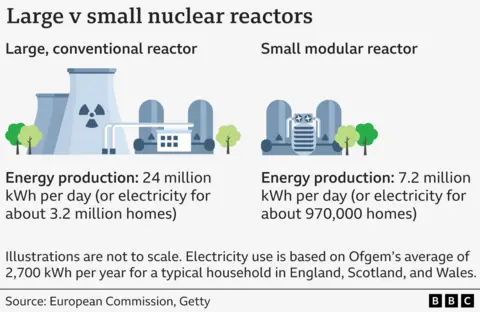 BBC Information
BBC InformationSMRs, typically referred to as “mini nukes”, work on the identical precept as massive reactors, utilizing a nuclear response to generate warmth that produces electrical energy.
Inside a number of massive reactor vessels, atoms of nuclear gasoline are break up, releasing a considerable amount of warmth. That’s used to warmth water, which drives a turbine. Primarily, reactors are big nuclear kettles.
SMRs shall be a fraction of the scale and have as much as a 3rd of the producing output of a typical massive reactor.
The modular factor means they are going to be constructed to order in factories – as a equipment of components – then transported and fitted collectively, like a flat-packed energy station.
The intention is to avoid wasting money and time
Why does the UK need ‘mini nukes’?
The federal government desires a safe, dependable, inexpensive and low carbon power system.
In 2024, nuclear accounted for 14% of the UK’s electrical energy technology, in response to provisional authorities figures. The intention is to spice up that.
Together with 30 different international locations, the UK has signed a worldwide pledge to triple nuclear capability by 2050.
However no new nuclear energy station has been constructed since Sizewell B started working in 1995. And most of these in operation are resulting from be retired by the tip of the last decade.
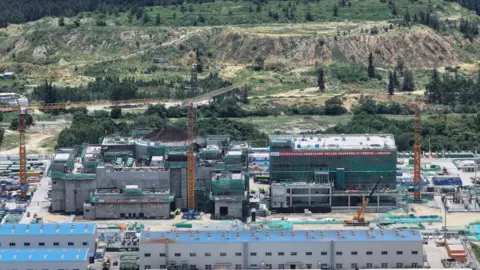 Getty Pictures
Getty PicturesThe SMR business is in its infancy and, all over the world, about 80 completely different designs are being investigated.
Solely China and Russia have small reactors up and working.
The UK authorities is satisfied that, with funding, SMRs will create 1000’s of jobs and increase manufacturing.
Initially although, each authorities and personal funding shall be wanted to show the designs right into a commercially viable actuality.
Within the US, firms together with Google, Microsoft and Amazon, with their power-hungry information centres, have signed a deal to make use of the reactors after they turn into accessible.
The place will small modular reactors be constructed?
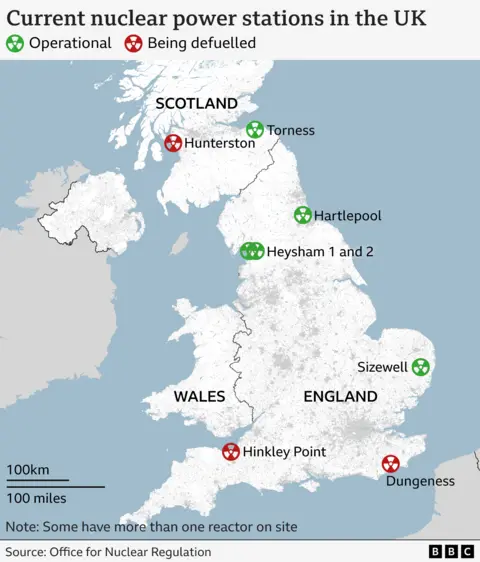 BBC Information
BBC InformationIn 2011, the Conservative authorities recognized eight websites for “new nuclear” (bigger reactors), at Bradwell, Hartlepool, Heysham, Hinkley Level, Oldbury, Sellafield, Sizewell and Wylfa.
Then, in February 2025, the prime minister stated he would reduce planning pink tape to make it simpler for builders to construct smaller nuclear reactors on extra websites throughout the nation.
Sure standards must be met, Sir Keir Starmer stated. No websites can be permitted near airports, navy websites or pipelines. Places precious for nature or prone to flooding would even be dominated out.
Nice British Nuclear, a public physique with statutory powers to push by means of the federal government’s nuclear plans, ran a contest to discover a agency that may develop and construct SMRs within the UK.
It goals to pick and announce a location by the tip of 2025, with the primary SMR operational by the mid 2030s.
Most popular areas are prone to embrace previous industrial websites, corresponding to former nuclear vegetation, or previous coal mines near the grid.
Rolls Royce beat two American consortiums within the competitors, Holtec, GE Hitachi. A Canadian firm, Westinghouse pulled out.
Will SMRs reduce electricty payments?
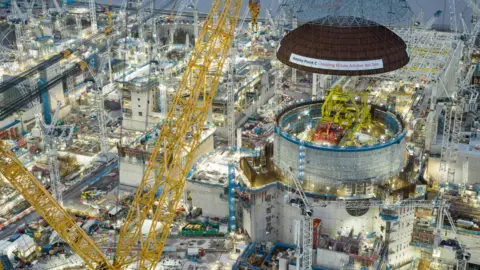 EDF
EDFThe monetary controversy across the new massive reactor being constructed at Hinkley Level C in Somerset is an ideal instance of what the UK is attempting to maneuver away from. It’s working a decade late and has overspent by billions of kilos.
SMRs promise to be faster, simpler and cheaper to construct.
However whereas they may finally be constructed to order, price financial savings do not kick in till designs have been finalised and modules are reliably rolling off manufacturing facility traces.
So the primary SMRs will in all probability be very costly to construct.
The price of coping with nuclear waste additionally must be factored in. Sellafield, in Cumbria, at present offers with many of the nation’s waste, however it’s working out of area and prices are spiralling.
In 2024, main nuclear scientists on a authorities advisory committee beneficial any new nuclear energy station design ought to embrace clear plans for managing waste, to keep away from the “expensive mistake of the previous”.
Taxpayers right this moment are nonetheless paying for Sellafield to cope with nuclear waste from the Nineteen Fifties.
Nuclear business specialists the BBC has spoken to are satisfied that SMRs – and extra nuclear energy – will finally scale back the price of our electrical energy provide.
Public attitudes to nuclear energy look like linked to these costs. A authorities survey in 2024 urged that 78% of individuals would discover an power infrastructure mission extra acceptable in the event that they have been supplied reductions on their payments.
Though the federal government has introduced reductions on electrical energy payments for households near upgraded pylons, there was no such announcement but referring to houses close to SMRs.
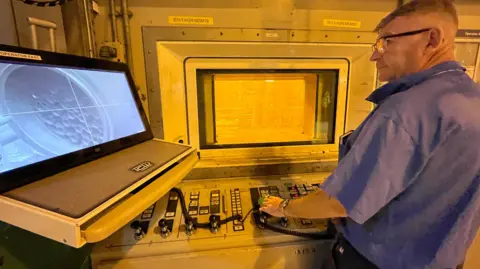 Kate Stephens/BBC Information
Kate Stephens/BBC InformationHow secure are small modular reactors?
The Worldwide Atomic Vitality Company says nuclear energy vegetation are amongst “the most secure and most safe services on this planet”.
Nuclear energy’s status is tarnished although by excessive profile disasters, the place radioactive materials has been launched into the surroundings – together with in Chernobyl, Ukraine, in 1986 and Fukushima in Japan, in 2011.
Dr Simon Middleburgh, a nuclear scientist from Bangor College, whose analysis focuses on creating new nuclear supplies, describes the smaller reactors which might be being thought of for the UK as “extremely secure”.
“The UK’s ONR (Workplace for Nuclear Regulation) is handled as a type of gold normal internationally when it comes to the regulatory surroundings,” he instructed BBC Information.
 Getty Pictures
Getty PicturesWhat about nuclear waste and safety?
Some specialists do have issues about nuclear waste. Scientists from the federal government advisory group not too long ago stated the problem of how radioactive waste from SMRs which might be within the design stage “seems, with some exceptions… to have been largely ignored or a minimum of downplayed”.
The quantity and placement of SMRs can be a safety difficulty.
With extra reactors unfold over a bigger space, doubtlessly constructed on industrial websites and nearer to folks, Dr Ross Peel, a researcher in civil nuclear safety from Kings Faculty London, says the safety burden shall be increased.
Safety at nuclear energy stations is offered by armed police – the Civil Nuclear Constabulary. Dr Peel says the truth that current nuclear websites typically have “miles of empty land round them” signifies that anybody within the neighborhood arouses suspicion. If officers spot anybody they might simply “look by means of the binoculars and ask ‘what are you doing?’,” he stated.
“In city or industrial environments, all of the sudden you are attempting to do safety in a really completely different [way].”


